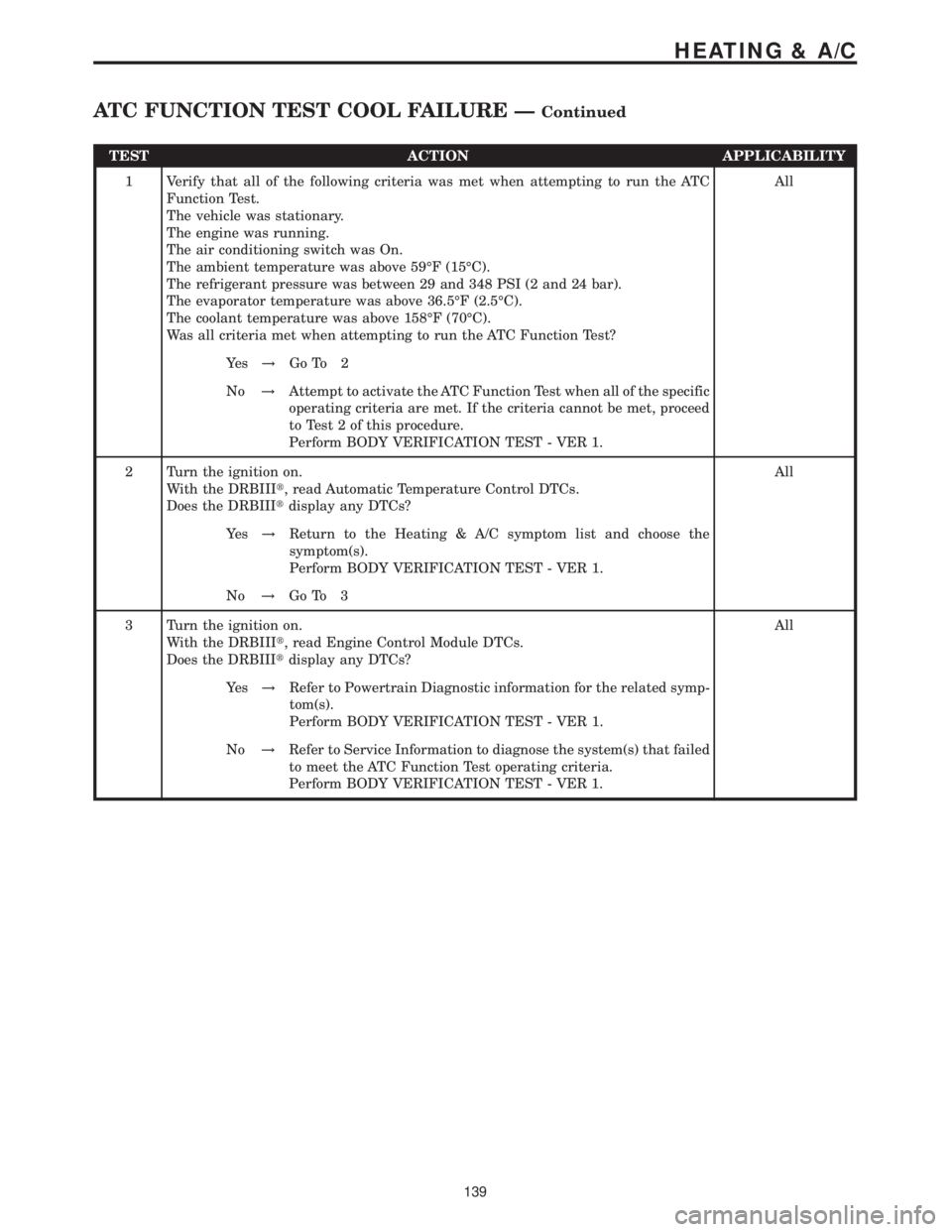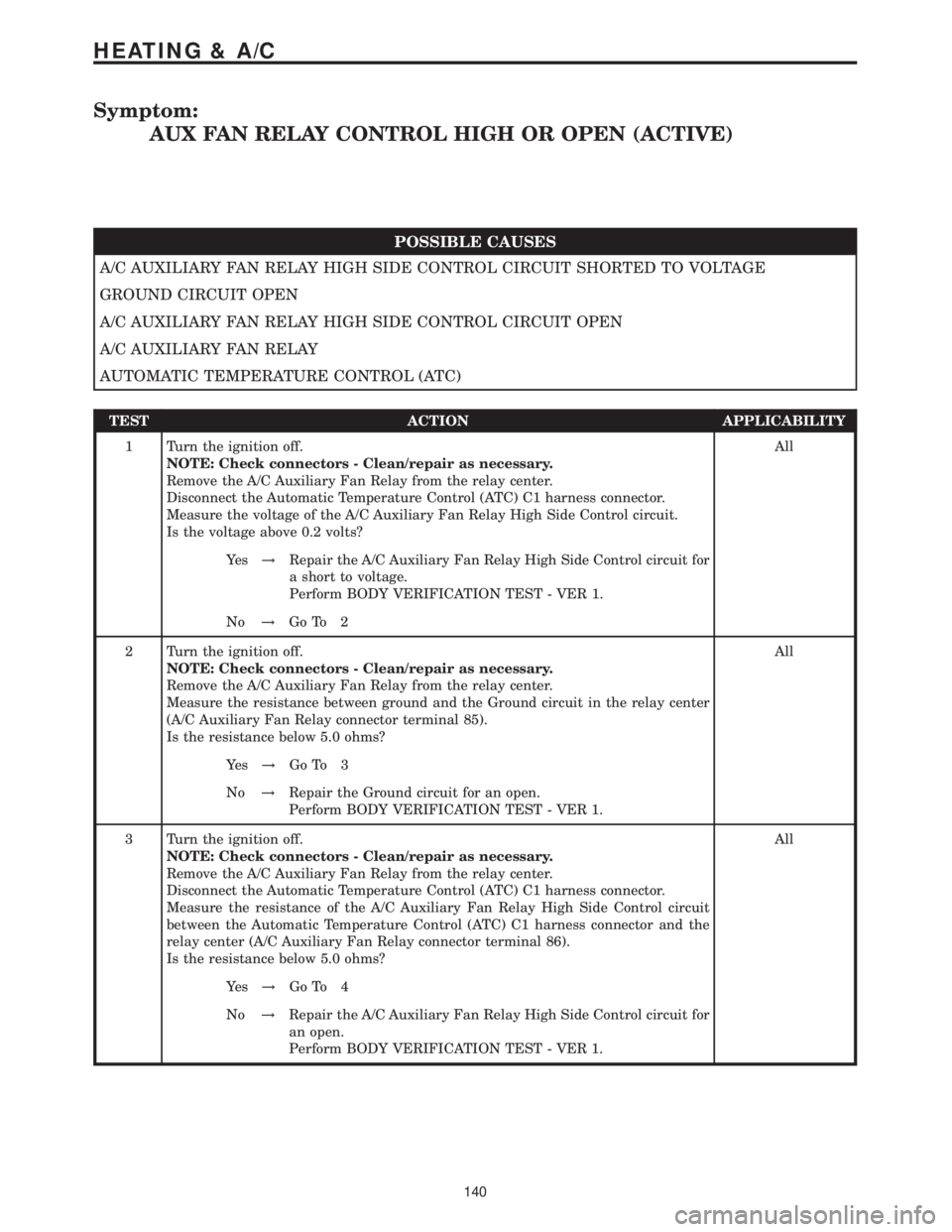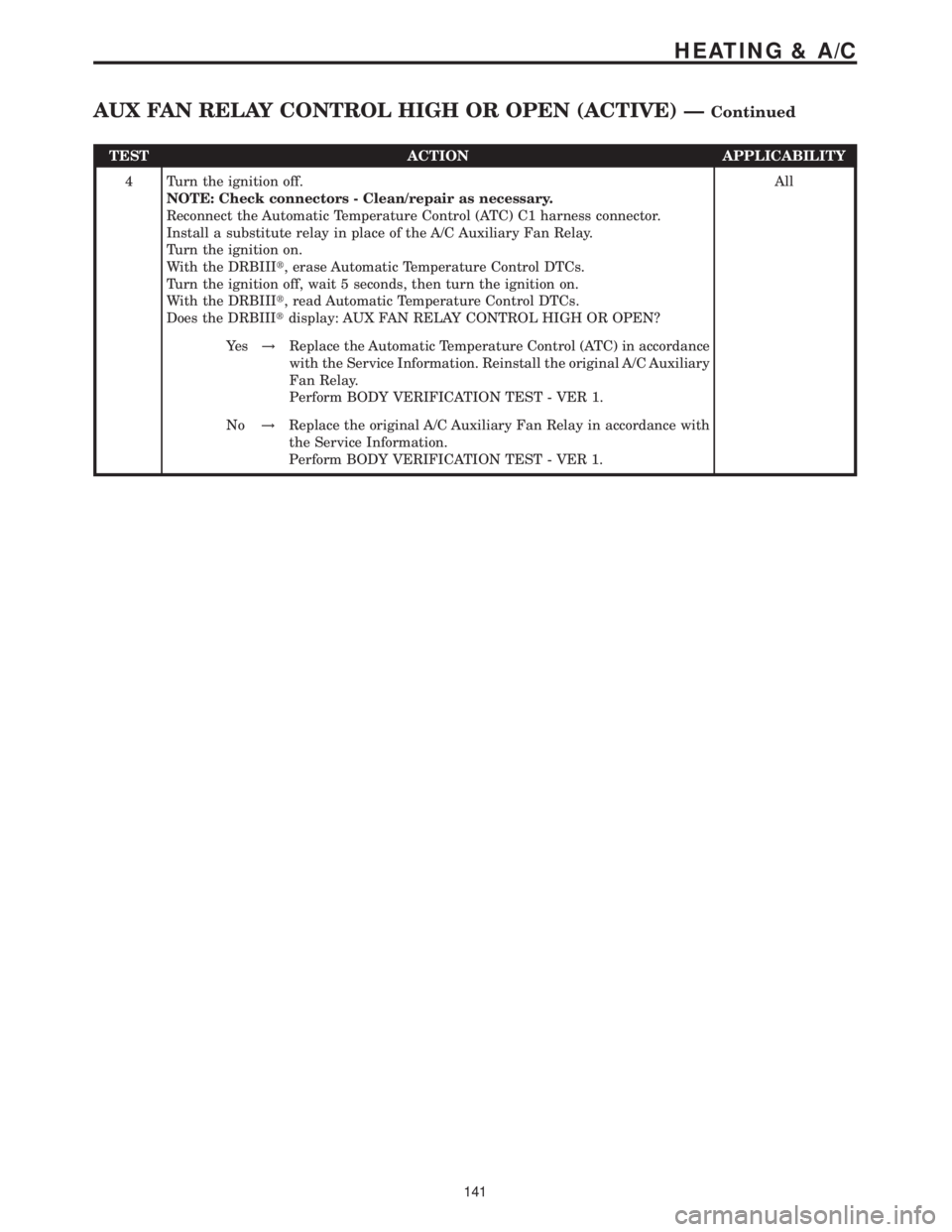2006 MERCEDES-BENZ SPRINTER ignition
[x] Cancel search: ignitionPage 147 of 2305

Symptom:
AIR OUTLET TEMP SENSOR HIGH OR OPEN (ACTIVE)
POSSIBLE CAUSES
AIR OUTLET TEMPERATURE SENSOR SIGNAL CIRCUIT SHORTED TO VOLTAGE
AUTOMATIC TEMPERATURE CONTROL (ATC)
AUTOMATIC TEMPERATURE CONTROL (ATC)
AIR OUTLET TEMPERATURE SENSOR SIGNAL CIRCUIT OPEN
SENSOR GROUND CIRCUIT OPEN
AIR OUTLET TEMPERATURE SENSOR
TEST ACTION APPLICABILITY
1 Turn the ignition off.
NOTE: Check connectors - Clean/repair as necessary.
Disconnect the Air Outlet Temperature Sensor harness connector.
Turn the ignition on.
While back probing, measure the voltage between the Air Outlet Temperature Sensor
Signal circuit and the Sensor Ground circuit.
Is the voltage above 5.3 volts?All
Ye s!Go To 2
No!Go To 3
2 Turn the ignition off.
NOTE: Check connectors - Clean/repair as necessary.
Disconnect the Air Outlet Temperature Sensor harness connector.
Disconnect the Automatic Temperature Control (ATC) C1 harness connector.
Turn the ignition on.
Measure the voltage of the Air Outlet Temperature Sensor Signal circuit.
Is the voltage above 0.2 volts?All
Ye s!Repair the Air Outlet Temperature Sensor Signal circuit for a
short to voltage.
Perform BODY VERIFICATION TEST - VER 1.
No!Replace the Automatic Temperature Control (ATC) in accordance
with the Service Information.
Perform BODY VERIFICATION TEST - VER 1.
3 Turn the ignition off.
NOTE: Check connectors - Clean/repair as necessary.
Disconnect the Air Outlet Temperature Sensor harness connector.
Turn the ignition on.
While back probing, measure the voltage between the Air Outlet Temperature Sensor
Signal circuit and Sensor Ground circuit in the Automatic Temperature Control
(ATC) C1 harness connector.
Is the voltage above 4.5 volts?All
Ye s!Go To 4
No!Replace the Automatic Temperature Control (ATC) in accordance
with the Service Information.
Perform BODY VERIFICATION TEST - VER 1.
134
HEATING & A/C
Page 148 of 2305

TEST ACTION APPLICABILITY
4 Turn the ignition off.
NOTE: Check connectors - Clean/repair as necessary.
Disconnect the Automatic Temperature Control (ATC) C1 harness connector.
Disconnect the Air Outlet Temperature Sensor harness connector.
Measure the resistance of the Air Outlet Temperature Sensor Signal circuit between
the Automatic Temperature Control (ATC) C1 harness connector and the Air Outlet
Temperature Sensor harness connector.
Is the resistance below 5.0 ohms?All
Ye s!Go To 5
No!Repair the Air Outlet Temperature Sensor Signal circuit for an
open.
Perform BODY VERIFICATION TEST - VER 1.
5 Turn the ignition off.
NOTE: Check connectors - Clean/repair as necessary.
Disconnect the Automatic Temperature Control (ATC) C1 harness connector.
Disconnect the Air Outlet Temperature Sensor harness connector.
Measure the resistance of the Sensor Ground circuit between the Automatic
Temperature Control (ATC) C1 harness connector and the Air Outlet Temperature
Sensor harness connector.
Is the resistance below 5.0 ohms?All
Ye s!Replace the Air Outlet Temperature Sensor in accordance with
the Service Information.
Perform BODY VERIFICATION TEST - VER 1.
No!Repair the Sensor Ground circuit for an open.
Perform BODY VERIFICATION TEST - VER 1.
135
HEATING & A/C
AIR OUTLET TEMP SENSOR HIGH OR OPEN (ACTIVE) ÐContinued
Page 149 of 2305

Symptom:
AIR OUTLET TEMP SENSOR SHORTED LOW (ACTIVE)
POSSIBLE CAUSES
AIR OUTLET TEMPERATURE SENSOR
AIR OUTLET TEMPERATURE SENSOR SIGNAL CIRCUIT SHORTED TO GROUND
AIR OUTLET TEMPERATURE SENSOR SIGNAL CIRCUIT SHORTED TO GROUND CIRCUIT
AUTOMATIC TEMPERATURE CONTROL (ATC)
AIR OUTLET TEMPERATURE SENSOR SIGNAL CIRCUIT SHORT TO SENSOR GROUND CIR-
CUIT
TEST ACTION APPLICABILITY
1 Turn the ignition off.
Disconnect the Air Outlet Temperature Sensor harness connector.
Turn the ignition on.
With the DRBIIIt, record and erase Automatic Temperature Control DTCs.
Turn the ignition off, wait 5 seconds, then turn the ignition on.
With the DRBIIIt, read the Automatic Temperature Control DTCs.
Does the DRBIIItdisplay: AIR OUTLET TEMP SENSOR HIGH OR OPEN?All
Ye s!Replace the Air Outlet Temperature Sensor in accordance with
the Service Information.
Perform BODY VERIFICATION TEST - VER 1.
No!Go To 2
2 Turn the ignition off.
Disconnect the Automatic Temperature Control (ATC) C1 harness connector.
Measure the resistance between ground and the Air Outlet Temperature Sensor
Signal circuit.
Is the resistance below 10k ohms?All
Ye s!Repair the Air Outlet Temperature Sensor Signal circuit for a
short to ground.
Perform BODY VERIFICATION TEST - VER 1.
No!Go To 3
3 Turn the ignition off.
Disconnect the Automatic Temperature Control (ATC) C1 harness connector.
Measure the resistance between the Air Outlet Temperature Sensor Signal circuit
and the Ground circuit.
Is the resistance below 10k ohms?All
Ye s!Repair the Air Outlet Temperature Sensor Signal circuit for a
short to the Ground circuit.
Perform BODY VERIFICATION TEST - VER 1.
No!Go To 4
136
HEATING & A/C
Page 150 of 2305

TEST ACTION APPLICABILITY
4 Turn the ignition off.
Disconnect the Air Outlet Temperature Sensor harness connector.
Disconnect the Automatic Temperature Control (ATC) C1 harness connector.
Measure the resistance between the Air Outlet Temperature Sensor Signal circuit
and the Sensor Ground circuit.
Is the resistance below 10k ohms?All
Ye s!Repair the Air Outlet Temperature Sensor Signal circuit for a
short to the Sensor Ground circuit.
Perform BODY VERIFICATION TEST - VER 1.
No!Replace the Automatic Temperature Control (ATC) in accordance
with the Service Information.
Perform BODY VERIFICATION TEST - VER 1.
137
HEATING & A/C
AIR OUTLET TEMP SENSOR SHORTED LOW (ACTIVE) ÐContinued
Page 152 of 2305

TEST ACTION APPLICABILITY
1 Verify that all of the following criteria was met when attempting to run the ATC
Function Test.
The vehicle was stationary.
The engine was running.
The air conditioning switch was On.
The ambient temperature was above 59ÉF (15ÉC).
The refrigerant pressure was between 29 and 348 PSI (2 and 24 bar).
The evaporator temperature was above 36.5ÉF (2.5ÉC).
The coolant temperature was above 158ÉF (70ÉC).
Was all criteria met when attempting to run the ATC Function Test?All
Ye s!Go To 2
No!Attempt to activate the ATC Function Test when all of the specific
operating criteria are met. If the criteria cannot be met, proceed
to Test 2 of this procedure.
Perform BODY VERIFICATION TEST - VER 1.
2 Turn the ignition on.
With the DRBIIIt, read Automatic Temperature Control DTCs.
Does the DRBIIItdisplay any DTCs?All
Ye s!Return to the Heating & A/C symptom list and choose the
symptom(s).
Perform BODY VERIFICATION TEST - VER 1.
No!Go To 3
3 Turn the ignition on.
With the DRBIIIt, read Engine Control Module DTCs.
Does the DRBIIItdisplay any DTCs?All
Ye s!Refer to Powertrain Diagnostic information for the related symp-
tom(s).
Perform BODY VERIFICATION TEST - VER 1.
No!Refer to Service Information to diagnose the system(s) that failed
to meet the ATC Function Test operating criteria.
Perform BODY VERIFICATION TEST - VER 1.
139
HEATING & A/C
ATC FUNCTION TEST COOL FAILURE ÐContinued
Page 153 of 2305

Symptom:
AUX FAN RELAY CONTROL HIGH OR OPEN (ACTIVE)
POSSIBLE CAUSES
A/C AUXILIARY FAN RELAY HIGH SIDE CONTROL CIRCUIT SHORTED TO VOLTAGE
GROUND CIRCUIT OPEN
A/C AUXILIARY FAN RELAY HIGH SIDE CONTROL CIRCUIT OPEN
A/C AUXILIARY FAN RELAY
AUTOMATIC TEMPERATURE CONTROL (ATC)
TEST ACTION APPLICABILITY
1 Turn the ignition off.
NOTE: Check connectors - Clean/repair as necessary.
Remove the A/C Auxiliary Fan Relay from the relay center.
Disconnect the Automatic Temperature Control (ATC) C1 harness connector.
Measure the voltage of the A/C Auxiliary Fan Relay High Side Control circuit.
Is the voltage above 0.2 volts?All
Ye s!Repair the A/C Auxiliary Fan Relay High Side Control circuit for
a short to voltage.
Perform BODY VERIFICATION TEST - VER 1.
No!Go To 2
2 Turn the ignition off.
NOTE: Check connectors - Clean/repair as necessary.
Remove the A/C Auxiliary Fan Relay from the relay center.
Measure the resistance between ground and the Ground circuit in the relay center
(A/C Auxiliary Fan Relay connector terminal 85).
Is the resistance below 5.0 ohms?All
Ye s!Go To 3
No!Repair the Ground circuit for an open.
Perform BODY VERIFICATION TEST - VER 1.
3 Turn the ignition off.
NOTE: Check connectors - Clean/repair as necessary.
Remove the A/C Auxiliary Fan Relay from the relay center.
Disconnect the Automatic Temperature Control (ATC) C1 harness connector.
Measure the resistance of the A/C Auxiliary Fan Relay High Side Control circuit
between the Automatic Temperature Control (ATC) C1 harness connector and the
relay center (A/C Auxiliary Fan Relay connector terminal 86).
Is the resistance below 5.0 ohms?All
Ye s!Go To 4
No!Repair the A/C Auxiliary Fan Relay High Side Control circuit for
an open.
Perform BODY VERIFICATION TEST - VER 1.
140
HEATING & A/C
Page 154 of 2305

TEST ACTION APPLICABILITY
4 Turn the ignition off.
NOTE: Check connectors - Clean/repair as necessary.
Reconnect the Automatic Temperature Control (ATC) C1 harness connector.
Install a substitute relay in place of the A/C Auxiliary Fan Relay.
Turn the ignition on.
With the DRBIIIt, erase Automatic Temperature Control DTCs.
Turn the ignition off, wait 5 seconds, then turn the ignition on.
With the DRBIIIt, read Automatic Temperature Control DTCs.
Does the DRBIIItdisplay: AUX FAN RELAY CONTROL HIGH OR OPEN?All
Ye s!Replace the Automatic Temperature Control (ATC) in accordance
with the Service Information. Reinstall the original A/C Auxiliary
Fan Relay.
Perform BODY VERIFICATION TEST - VER 1.
No!Replace the original A/C Auxiliary Fan Relay in accordance with
the Service Information.
Perform BODY VERIFICATION TEST - VER 1.
141
HEATING & A/C
AUX FAN RELAY CONTROL HIGH OR OPEN (ACTIVE) ÐContinued
Page 155 of 2305

Symptom:
AUX FAN RELAY CONTROL SHORTED LOW (ACTIVE)
POSSIBLE CAUSES
A/C AUXILIARY FAN RELAY
A/C AUXILIARY FAN RELAY HIGH SIDE CONTROL CIRCUIT SHORTED TO GROUND
A/C AUXILIARY FAN RELAY HIGH SIDE CONTROL CIRCUIT SHORTED TO GROUND CIRCUIT
AUTOMATIC TEMPERATURE CONTROL (ATC)
A/C AUXILIARY FAN RELAY HIGH SIDE CONTROL CKT SHORTED TO SENSOR GROUND CKT
TEST ACTION APPLICABILITY
1 Turn the ignition off.
Install a substitute relay in place of the A/C Auxiliary Fan Relay.
NOTE: All of the following criteria must be met in order to successfully run
the ATC Function Test.
Place the shift lever in Park.
Turn the ignition on.
With the DRBIIIt, record and erase ATC DTC's.
Start the engine. Allow the engine to reach normal operating temperature.
Set the blower to high speed.
Press the Air Conditioning switch On.
With the DRBIIIt, verify that the ambient temperature is above 59ÉF (15ÉC), the
refrigerant pressure is between 29 and 348 PSI (2 and 24 bar), the evaporator
temperature is above 36.5ÉF (2.5ÉC), and the coolant temperature is above 158ÉF
(70ÉC).
With the DRBIIItin Automatic Temperature Control (ATC), select System Tests and
select ATC Function Test. When the ATC Function Test is complete, proceed as
follows:
With the DRBIIIt, read the active ATC DTCs.
Does the DRBIIItdisplay: AUX FAN RELAY CONTROL SHORTED LOW?All
Ye s!Go To 2
No!Replace the original A/C Auxiliary Fan Relay in accordance with
the Service Information.
Perform BODY VERIFICATION TEST - VER 1.
2 Turn the ignition off.
Remove the substitute A/C Auxiliary Fan Relay from the relay center.
Disconnect the Automatic Temperature Control (ATC) C1 harness connector.
Measure the resistance between ground and the A/C Auxiliary Fan Relay High Side
Control circuit.
Is the resistance below 10K ohms?All
Ye s!Repair the A/C Auxiliary Fan Relay High Side Control circuit for
a short to ground. Reinstall the original A/C Auxiliary Fan Relay.
Perform BODY VERIFICATION TEST - VER 1.
No!Go To 3
142
HEATING & A/C